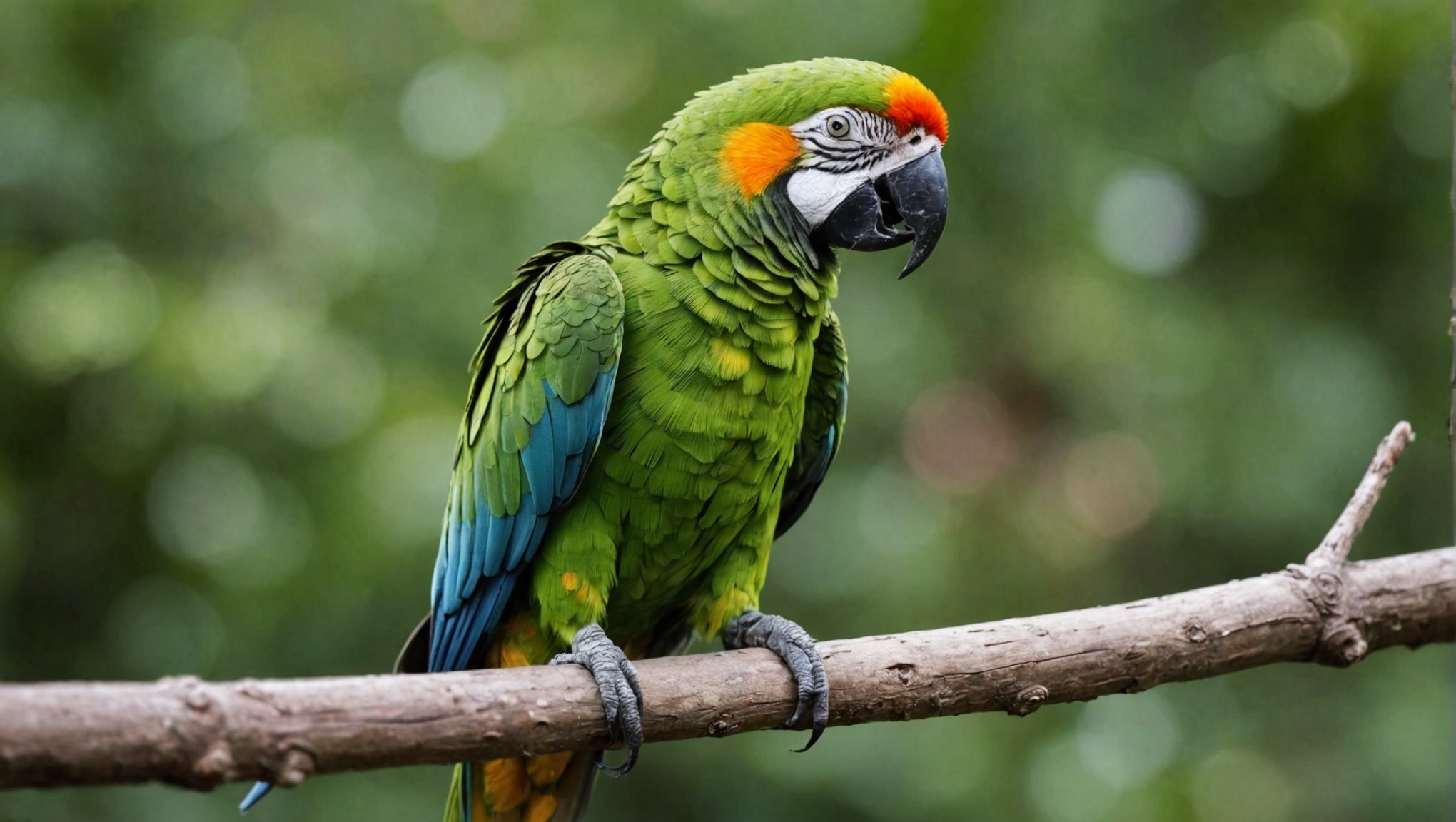Ultimate Guide: Effectively Introducing Your Rescue Parrot to Other Birds
Introducing a new parrot to your existing flock can be a daunting task, especially if the new bird is a rescue with an uncertain past. However, with the right approach, patience, and understanding, you can create a harmonious and happy home for all your birds. Here’s a comprehensive guide to help you through this process.
Preparing Your Home and Existing Birds
Before bringing your new rescue parrot home, it’s crucial to prepare your environment and your existing birds for the new addition.
Also read : Mastering the Art of Bathing: Effective Techniques for Water-Resistant Cats
Assess Your Home
Ensure your home is bird-proofed to prevent any accidents or injuries. This includes securing loose wires, removing toxic substances, and blocking off areas you don’t want your birds to access. Here are some key points to consider:
- Bird-Proofing: Move any breakable or valuable items out of reach. Parrots, especially intelligent ones like the Moluccan Cockatoo, are notorious for their curiosity and love for destruction[4].
- Noise Levels: If you have neighbors, consider the noise levels that your birds might generate. Some parrots, like the Moluccan Cockatoo, are extremely loud and may not be suitable for apartment living[4].
- Space: Ensure you have enough space for all your birds to fly, play, and live comfortably. A walk-in aviary or a large cage is ideal for providing the necessary room for your parrots[4].
Prepare Your Existing Birds
Your existing birds may feel threatened or territorial when a new bird is introduced. Here’s how you can prepare them:
Also to read : Effective Strategies for Treating and Preventing Chronic Ear Infections in Dogs
- Maintain Routine: Stick to your regular feeding, playtime, and sleep schedules to provide a sense of stability and normalcy.
- Increase Attention: Spend extra time with your existing birds before the new parrot arrives to reassure them that they are still loved and valued.
- Separate Areas: Designate separate areas for your existing birds and the new parrot initially to prevent immediate confrontations.
Step-by-Step Introduction Process
The introduction process should be gradual and controlled to avoid any conflicts.
Step 1: Visual Introduction
Start by allowing the birds to see each other but keep them separated. This can be done by placing their cages or aviaries in the same room but at a safe distance.
- Observe Behavior: Watch the body language of both the new parrot and your existing birds. If you notice any signs of aggression or fear, slow down the introduction process.
- Positive Reinforcement: Reward calm behavior with treats and praise to reinforce positive interactions.
Step 2: Scent Introduction
Once the birds seem comfortable with each other’s presence, it’s time to introduce their scents.
- Swap Perches: Swap the perches or toys between the cages to allow the birds to get used to each other’s scents.
- Exchange Bedding: Exchange some of the bedding material from the cages to help the birds become familiar with the new scents.
Step 3: Controlled Face-to-Face Introduction
When both birds seem calm and curious, it’s time for a supervised face-to-face introduction.
- Neutral Area: Choose a neutral area where neither bird feels territorial. This could be a playroom or a separate area of your home.
- Use a Carrier: If possible, use a carrier or a separate cage to introduce the birds in a controlled environment.
- Monitor Closely: Always monitor the interaction closely and be prepared to intervene if necessary.
Tips for a Smooth Transition
Here are some additional tips to ensure a smooth transition for your new rescue parrot and your existing birds:
Provide Multiple Resources
Ensure each bird has its own food, water, and perches to avoid competition.
- Multiple Food Stations: Set up multiple food stations to prevent competition over food.
- Several Perches: Provide several perches and roosting bars to give each bird its own space.
Increase Training and Socialization
Training and socialization are key to integrating your new parrot into the flock.
- Parrot Training: Use positive reinforcement training methods to help your new parrot adjust to its new environment. This includes teaching basic commands and tricks[3].
- Socialization: Spend quality time with your new parrot, engaging in activities like playing, cuddling, and feeding treats from your hand.
Manage Hormonal Behavior
Some parrots, especially those that are hormonal, may exhibit aggressive or territorial behavior.
- Diet and Lighting: Adjust the diet and lighting to manage hormonal behavior. For example, reducing daylight hours can help reduce breeding behaviors[3].
- Provide Mental Stimulation: Ensure your parrots have enough mental stimulation through toys, puzzles, and interactive activities to keep them occupied and happy.
Practical Insights and Actionable Advice
Here are some practical insights and actionable advice to help you navigate the introduction process:
Be Patient
Introducing a new parrot to your flock is not a one-day process. It requires patience and time.
- Gradual Introduction: Take the introduction process slowly and gradually. Rushing it can lead to conflicts and stress for both the new and existing birds.
- Consistency: Maintain consistency in your routine and interactions with your birds to provide a sense of stability.
Seek Professional Advice
If you are unsure about any part of the introduction process, it’s always best to seek advice from a professional.
- Veterinarian: Consult with a veterinarian who specializes in birds to get advice on the health and well-being of your new parrot.
- Behaviorist: If you notice any behavioral issues during the introduction process, consider consulting a bird behaviorist for personalized advice.
Table: Comparing Needs of Different Parrot Species
Here is a comparative table highlighting the needs of different parrot species, which can help you understand the specific requirements of your birds:
| Parrot Species | Space Requirements | Noise Levels | Social Needs | Dietary Needs |
|---|---|---|---|---|
| Moluccan Cockatoo | Large aviary or cage | Very loud | High social needs, requires constant attention | Balanced diet with fruits, vegetables, and pellets[4] |
| African Grey | Large cage or aviary | Moderate | High social needs, requires interaction and training | Balanced diet with fruits, vegetables, and pellets |
| Budgie | Medium-sized cage | Low to moderate | Moderate social needs, can be kept in pairs | Seed-based diet with supplements of fruits and vegetables |
| Amazon Parrot | Large cage or aviary | Loud | High social needs, requires interaction and training | Balanced diet with fruits, vegetables, and pellets |
Quotes and Anecdotes
Here are some quotes and anecdotes that highlight the importance of careful introduction and proper care:
- “Introducing a new parrot to your flock is like introducing a new family member. It requires patience, understanding, and a lot of love.” – Dr. Jane Smith, Avian Veterinarian
- “I once introduced a Moluccan Cockatoo to my flock without proper preparation, and it ended in disaster. Now, I take the introduction process very seriously and ensure it’s done gradually and under close supervision.” – Sarah Johnson, Parrot Owner
Introducing a rescue parrot to your existing flock is a significant undertaking, but with the right approach, it can be a rewarding experience for both you and your birds. Here are some final tips to keep in mind:
- Make Sure Your Home is Ready: Ensure your home is bird-proofed and ready for the new addition.
- Prepare Your Existing Birds: Maintain their routine and provide extra attention before the new parrot arrives.
- Gradual Introduction: Take the introduction process slowly and under close supervision.
- Positive Reinforcement: Use positive reinforcement training methods to encourage good behavior.
- Seek Professional Advice: If needed, consult with a veterinarian or bird behaviorist for personalized advice.
By following these steps and tips, you can create a harmonious and happy home for all your birds, making the transition smooth and enjoyable for everyone involved.










